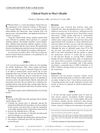Patterns of Care for Newly Diagnosed Benign Prostatic Hyperplasia in the United States
February 2016
in “
The Journal of urology/The journal of urology
”
TLDR Most care for benign prostatic hyperplasia follows guidelines, but 5-α reductase inhibitors are often used incorrectly.
The study analyzed diagnostic tests and treatment patterns for 38,252 men newly diagnosed with benign prostatic hyperplasia (BPH) using a national electronic health record database. Common diagnostic tests included serum creatinine (92%), serum prostate specific antigen (76%), and urinalysis (52%), with invasive testing performed in less than 20% of cases. Treatment approaches were watchful waiting (40%), pharmacological therapy (59.4%), and surgery (2.2%), with α-blockers prescribed to 50.7% of patients. Men over 65 and those with higher prostate specific antigen levels were less likely to undergo watchful waiting. The study concluded that while most clinical care aligned with guidelines, 5-α reductase inhibitor therapy was underutilized in men with large prostates and overutilized in those with small prostates.




